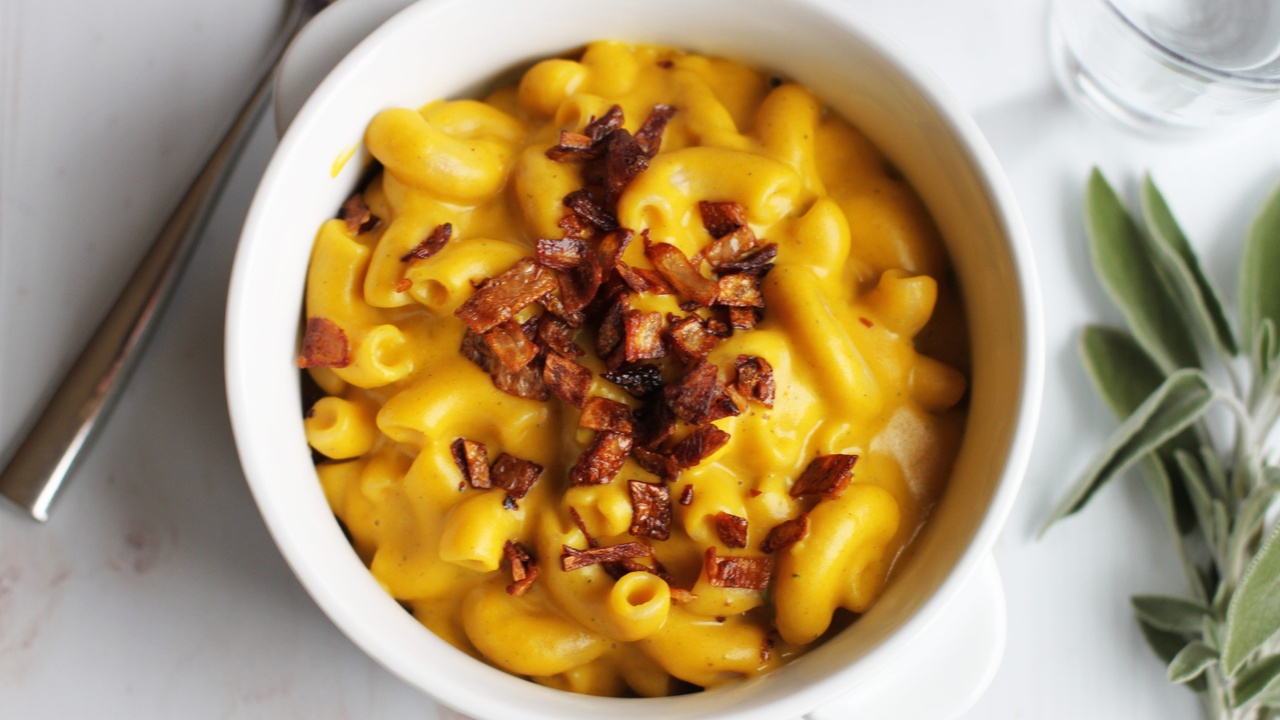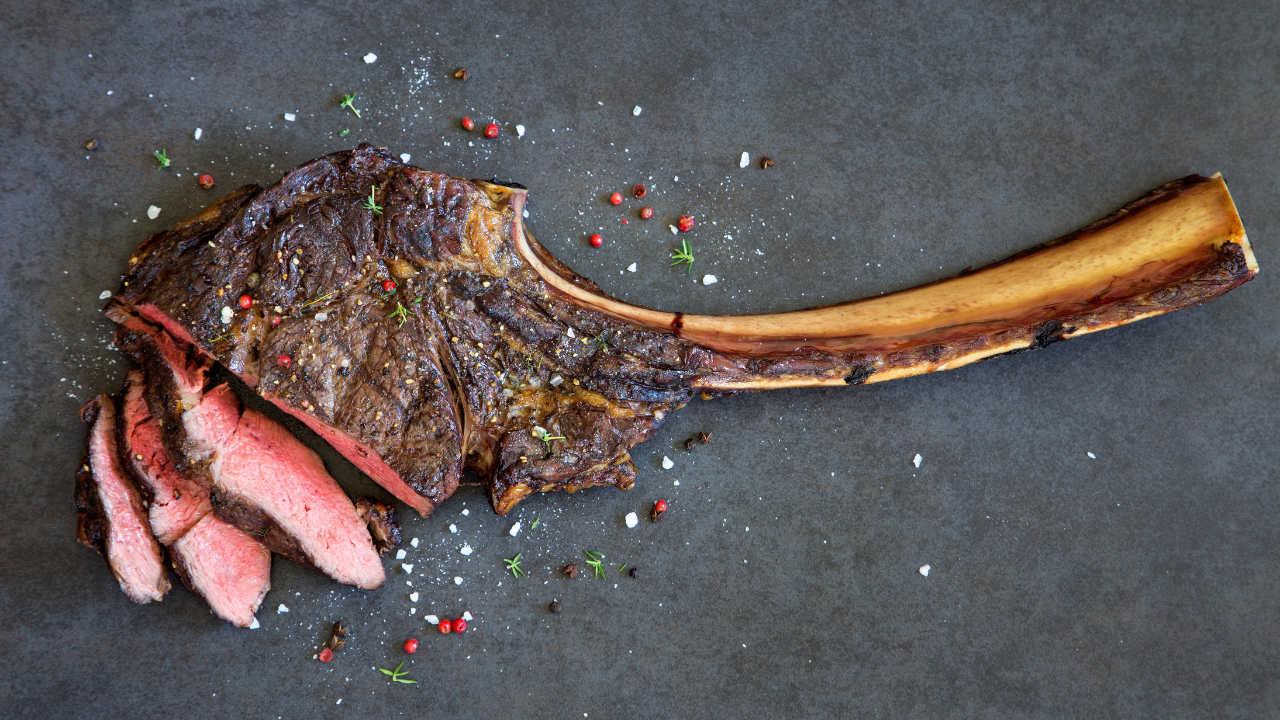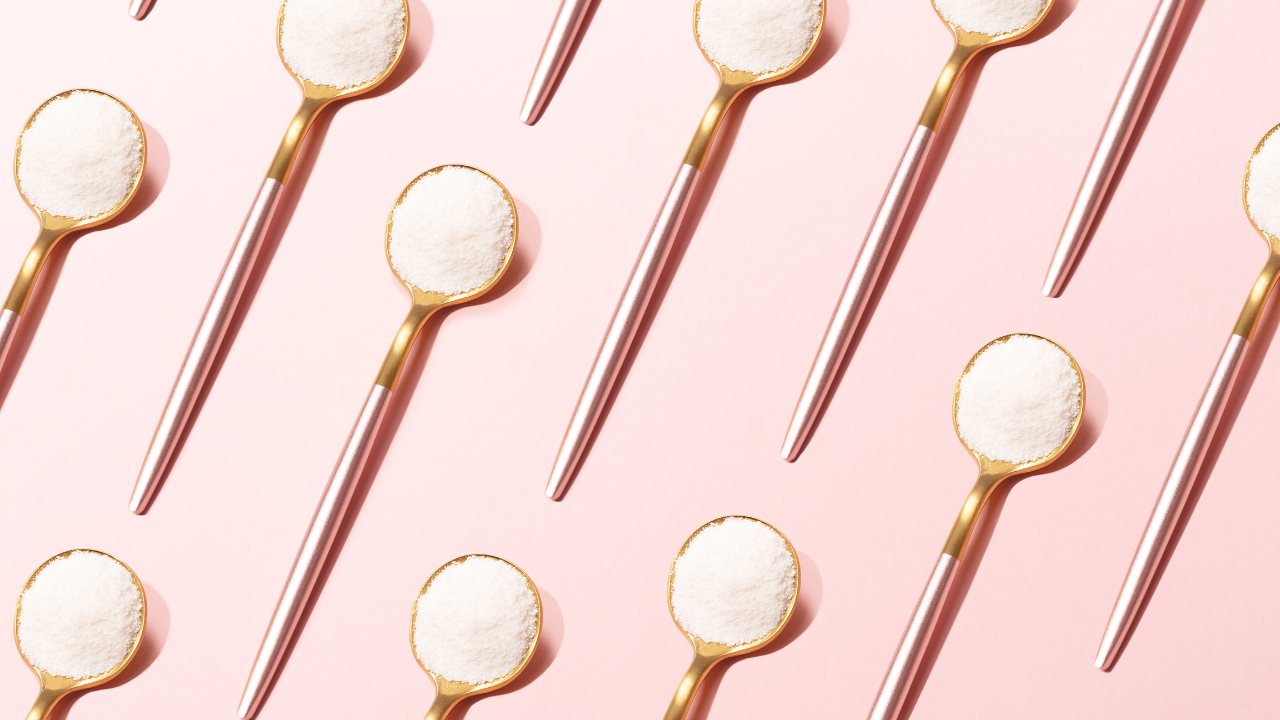Pumpkin Sage Macaroni and 'Cheese' with Crispy Shallot Topping

This sweet and savory macaroni and 'cheese' is made with roasted winter squash, fresh sage, and a subtle sprinkling of spices. The squash is the star of the sauce and gets added to a bone broth and coconut milk bechamel, made with ghee and a healthy dose of nutritional yeast for that umami 'cheesiness'. Once everything is blended to a smooth and velvety consistency, the sauce is tossed with gluten or grain-free pasta (depending on your current dietary needs), and then topped with crispy fried shallots for that perfect balance of flavor and crunch.
While it's nothing like your typical boxed mac and cheese dinner, this Pumpkin Sage Macaroni and 'Cheese' with Crispy Shallot Topping is its own glory, making winter squash irresistible with touches of the familiar. This is nutrient-dense, thyroid-healthy comfort food. Most importantly, it's absolutely delicious.
This recipe is gluten and dairy-free. If you use grain and legume-free pasta, like this Cassava Macaroni from Jovial, it's also Paleo-compliant.
Full disclosure: Some of the links in this post may be affiliate links. As an Amazon Associate, I earn from qualifying purchases. Purchasing a product using one of these links will support my work at no additional cost to you. Please know that I only recommend products I wholeheartedly stand by.
Chef's Notes
I started tinkering with this recipe around Thanksgiving, trying to re-create a beloved Butternut Mac & Cheese recipe from my pre-Hashi's life. The original was made with regular pasta, milk, and loads of cheese, with just a little bit of squash.
In this recipe facelift, I replaced the milk with coconut milk and broth, the cheese with nutritional yeast and dairy-free cream cheese, and the pasta with my favorite gluten-free brand of macaroni. I also dialed up the nutrient density by making squash the main event.
The tougher issue to solve was the original panko breadcrumb topping. There are plenty of GF breadcrumb options to choose from, but I didn't want to use a packaged ingredient, or something like nuts, plantain chips, or pork rinds.
I started thinking about the flavor combo of squash and caramelized onions, especially with the sage...mmmm. Crispy shallots are an absolute umami flavor bomb. Totally irresistible and unforgettable. Combining them with the natural sweetness of the squash, the savory sage, and the other spices seemed like a good idea...and it was.
To add even more of that caramelized onion goodness, I fried the shallots in ghee and then used that shallot-infused ghee to make the roux (a fat and flour paste used to thicken), which makes the bechamel (milk thickened with roux), which makes the 'cheese' sauce. That's a lot of culinary hullabaloo, but it's how scratch-made mac and cheese is prepared.
The result? Not only was it a flavor bullseye, it even passed the kid test!
I tried to follow my original recipe by creating a baked mac and cheese, but it was not a happy result. First of all, gluten-free pasta can be really good, until it's overcooked, which inevitably happens in the oven. Secondly, baking removes moisture, and with a starchy base like squash, the dish came out of the oven looking dried out and not very sexy.
It tasted great, but the texture and appearance weren't up to Hypothyroid Chef standards, so I tweaked some amounts and tried again. This time I smoothed the sauce with a blender to get rid of any stringy bits, tossed the velvety sauce with freshly cooked pasta, sprinkled on those crispy shallots, and dove right in. Ooh la la! Yesss.
While this would be a lovely fall recipe or Thanksgiving side, this Pumpkin Sage Macaroni and 'Cheese' is delicious any time of year that winter squashes are in season: fall, winter, even early spring or late summer.
Try this next: Stuffed Delicata Squash with Sausage, Greens, and Garlic
What's the Best Kind of Squash to Use?
For this recipe, any kind of sweet, pumpkin-type winter squash would work. I used Kabocha, which is like a small green pumpkin, with very sweet, bright orange flesh. Similar varieties include Sunshine, Jarrahdale, Cinderella, and Buttercup Squash. All of those varieties are pumpkin-shaped, with deep-orange flesh, and lots of natural sweetness. Part of what makes these varieties work well is that they provide a good amount of squash flesh, and are easy to roast, scoop, and mash.
That said, finding these varieties might be difficult, and I don’t want you to feel like it’s necessary to run around town hunting down a Kabocha when more common varieties like butternut or even canned pumpkin would make fine understudies.
Personally, I would avoid smaller (albeit still delicious) varieties like acorn, delicata, or carnival squash, mainly because they're too small to provide enough squash, and scooping the flesh can be a little bit awkward from deeply-ridged varieties. But if that’s what you have on hand, and you’re up for the extra prep time, there wouldn’t be anything wrong with how they would taste.
Best Squash Choices: Kabocha, Sunshine, Buttercup, Jarrahdale, Cinderella
Thyroid-healthy Highlights:
- 1 serving of winter squash contains between 150% and 450% DV for Vitamin A, which may help reduce the risk of developing hypothyroidism. Winter squash is also high in several other key thyroid supporting nutrients including vitamin C, vitamin B6, potassium, magnesium, and dietary fiber.
- Though it is naturally sweet and filling, the glycemic load for winter squash is very low, with a score of 5 out of 250, making it a good choice for weight loss.
- Coconut products such as coconut milk contain a wide array of vitamins and minerals, in addition to healthy fats known as MCTs (medium-chain triglycerides) or MCFAs (medium-chain fatty acids). Consumption of these fats has been touted for various health benefits such as brain health, weight loss, and cholesterol balance. Coconut can also be a positive dietary substitution for refined carbs and sugar, which can diminish thyroid and overall health. NOTE: Coconut milk does contain an incredibly high amount of fat (approx. 45g per can) – something to be mindful of for those watching their weight.
- Nutritional Yeast has many health benefits, especially for those who do not eat animal protein. It is a complete protein and a great source of B Vitamins and trace minerals. It also contains the potent antioxidants glutathione and selenomethionine, which can help protect us from chronic disease caused by oxidative stress, free radicals, and environmental toxins.
- Bone broth is one of the most highly recommended foods for anyone suffering from an autoimmune disease. The collagen and glycine can help repair cell damage in the intestinal tract. It also supports hair, skin, and nail health, as well as our body's detox pathways.
Happy cooking, happy thriving, and enjoy the recipe (below)!

P.S. Need more thyroid-friendly recipe inspiration? I’ve got you covered. My Thyroid-friendly Everyday eCookbook features over 50 quick and easy, thyroid-friendly recipes your whole family will love. To take a peek at what’s inside, CLICK HERE.
More Dairy-Free Sides to Try:
- Olive Oil Mashed Cauliflower & Sweet Potatoes
- Tuna Macaroni Salad (Gluten Free)
- Chive Potato Salad
- The Ultimate Gluten-free, Dairy-free Mashed Potatoes and Gravy
- Bacon and Chive Scalloped Potatoes
- Chex Mix-Inspired Delicata Rings
- Mashed Winter Squash, Three Ways
Subscribe to my free newsletter for fresh recipes & lifestyle tips, delivered weekly, and receive a free gift!
By submitting this form, you agree to receive ongoing updates from Hypothyroid Chef










